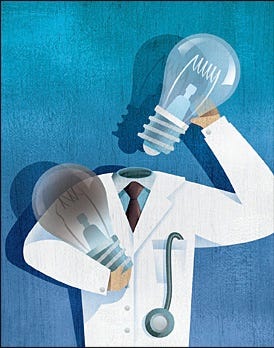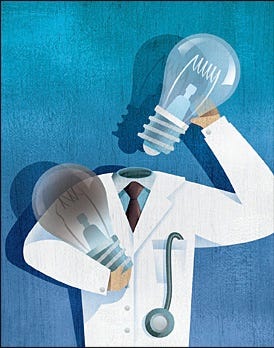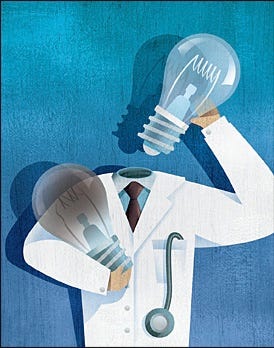Missouri Medicine
Megan Haghnegahdar, MD, Palash Sharma, Kevin P. Hubbard, DO & W. Abraham White, MD
January/February 2021
Executive Summary by:
Joaquim Cardoso MSc.
health transformation — content platform
September 19, 2022 (mindmattersmagazine)
Objective
- Approximately half of all U.S. medical students are experiencing burnout.
- A previous study has demonstrated that higher levels of spirituality are associated with less burnout in medical students, yet no studies have examined the relationship between religious affiliation and burnout in medical students.
- The purpose of this study is to determine if specific religious affiliation and level of religious involvement is associated with less burnout in medical students.
Methods
- A cross-sectional online survey was sent to all students attending five different osteopathic and allopathic medical schools in Kansas and Missouri.
- It contained a validated burnout measure, an item to identify religious affiliation, and items to quantify religious involvement.
Results
- A response rate of 11.5% (495/4,300) was obtained.
- An ANOVA showed religious affiliations and burnout scores did not have any statistically significant relationships (F = 0.762, P = 0.619). Additionally, identification as an active participant within a religious affiliation had a statistically significant effect on burnout scores (F = 7.793, P = 0.005).
Conclusions
- This is the first study within the U.S. to show that …
- (1) religious affiliation is not associated with medical student burnout …
- (2) … and that medical students who consider themselves to be active participants of their religion may be at lower risk of developing burnout, regardless of the faith they practice.
Approximately half of all U.S. medical students are experiencing burnout.
This is the first study within the U.S. to show that: (1) religious affiliation is not associated with medical student burnout …
(2) … and that medical students who consider themselves to be active participants of their religion may be at lower risk of developing burnout, regardless of the faith they practice.

Background
Burnout is defined as a “state of exhaustion in which one is cynical about the value of one’s occupation and doubtful of one’s capacity to perform.”1
As a topic that has been studied for decades, burnout has been notably recognized among physicians.
It is estimated that approximately 45.8% of U.S. physicians are experiencing burnout.2
Patients appear to also be impacted by this phenomenon, as studies have shown an increased frequency of self-perceived medical errors in physicians experiencing burnout.3,4
It is estimated that approximately 45.8% of U.S. physicians are experiencing burnout
A more recent topic of study is burnout during physician training, specifically during medical school.
Multiple investigations have been conducted to assess the prevalence of burnout in medical students and physicians which have demonstrated that the prevalence is variable, ranging from 2% to 76% based on the study samples, inclusion and exclusion criterial and geographic location.16,17,18,19,20,21,22
Multiple investigations have been conducted to assess the prevalence of burnout in medical students and physicians …, ranging from 2% to 76% based on the study samples,
In comparison to U.S. college graduates ages 22–32 years old, U.S. medical students have a higher prevalence of burnout.5
It is estimated that nearly 50% of all students enrolled in U.S. medical schools are experiencing burnout.6
Medical student burnout has been found to be more than a transient process and is associated with life-changing events.
One study found that burnout in medical students is associated with increased likelihood of serious thoughts of dropping out.7
Another found that burnout in medical students even predicts suicidal ideation.6
It is estimated that nearly 50% of all students enrolled in U.S. medical schools are experiencing burnout.
A great deal of research has been dedicated to understanding how religion and spirituality influence burnout among health care workers.
Spiritual well-being is associated with less burnout and greater resilience, particularly among nurses who work in high intensity settings.8,9,10
However, few efforts have been made to examine the role of religion in the prevention of burnout in medical students.
Spiritual well-being is associated with less burnout and greater resilience, particularly among nurses who work in high intensity settings.8,9,10
However, few efforts have been made to examine the role of religion in the prevention of burnout in medical students.
A study by Wachholtz and Ragoff that surveyed medical students at a New England public medical school explored the relationship between levels of spirituality and burnout.
They found that students with higher levels of spirituality are less likely to experience burnout.11
They additionally collected religious affiliations (i.e. Buddhist, Hindu, Muslim, etc.) of the students surveyed, but did not provide analysis outside of percentages of their sample size that identified with each religion.
a survey of medical students at a New England public medical school, … found that students with higher levels of spirituality are less likely to experience burnout.
They additionally collected religious affiliations (i.e. Buddhist, Hindu, Muslim, etc.) of the students surveyed, but did not provide analysis outside of percentages of their sample size that identified with each religion.
The aim of our study is to explore the relationship between religion and burnout in medical students.
Our goal is to determine if specific religious affiliation and level of religious involvement is associated with lower burnout scores in medical students.
Methods, and Results
See the original publication

Discussion
We found that there were no significant differences among the various religious affiliations in having lower burnout scores in medical students.
In other words, no religious affiliation had significantly lower burnout scores compared to the others.
We additionally found that self-perception in that one is an active participant within one’s religion is associated with lower burnout scores.
… no religious affiliation had significantly lower burnout scores compared to the others.
We additionally found that self-perception in that one is an active participant within one’s religion is associated with lower burnout scores.
However, there is no significant relationship between hours spent per week on religious activity and number of instances in a year spent participating in religious services.
Medical students already pressed for time due to their heavy volume of studies may wonder how much participation within their religion is adequate to prevent burnout.
Our study shows that self-identification as being an active participant alone is associated with lower burnout scores and that no exact quantification of time is associated with less burnout.
… self-identification as being an active participant alone is associated with lower burnout scores and that no exact quantification of time is associated with less burnout.
Interestingly, medical students who selected that they only attended religious services on religious holidays had significantly lower burnout scores.
It is challenging to decipher why only attending religious services on religious holidays is associated with less burnout.
We are interested in further studying this group within our sample to determine if other factors, such as demographics, contribute to this effect.
Additionally, the question style of this item may have led to a misunderstanding among participants, such as perceiving that the question asked if the participant attended religious services on holidays, rather than “only” on holidays.
There are likely many factors that influence medical student burnout, religion being a piece of this puzzle.
Our findings show no particular religious affiliation is associated with less burnout compared to others in medical students.
Additionally, our study gives evidence that self-perception as being an active participant in religion and only attending services on religious holidays is associated with less burnout in medical students.
The limitations of our study include low response rate, a relatively small geographic distribution of our sample, lack of demographic information, and the working of the religious services questions.
A poor response rate may have in fact be due to medical student burnout, causing them to avoid the survey.
Additionally, those who responded to the survey likely possess pro-social behavior characteristics, potentially skewing the data.
Future investigations should further explore the relationship between burnout and religious affiliation in both medical students and the general population using similar surveys.
Additionally, future efforts should be made to collect qualitative reports from students in survey format to identify which aspects of their religious affiliation they find to be most protective against burnout, as this may further direct future studies.

Conclusion
To our knowledge, this is the first study within the U.S. to examine the relationship between religious affiliation and burnout in medical students.
Our results suggest that medical students who consider themselves to be active participants of their religion may be at lower risk of developing burnout, regardless of the faith they practice.
Our results suggest that medical students who consider themselves to be active participants of their religion may be at lower risk of developing burnout, regardless of the faith they practice.
Our results suggest that medical students who consider themselves to be active participants of their religion may be at lower risk of developing burnout, regardless of the faith they practice.
About the authors & affiliations
Megan Haghnegahdar, MD, (above), is at the University of Kansas School of Medicine, (KUSOM) Kansas City, Kansas. Palash Sharma is in the Department of Biostatistics & Data Science, (KUSOM).
Kevin P. Hubbard, DO, HMDC, MACOI, is Professor of Internal Medicine and Chair, Department of Primary Care, Kansas City University of Medicine and Biosciences, Kansas City, Missouri. W.
Abraham White, MD, is Assistant Professor, Department of Ophthalmology, (KUSOM).
References and Additional Information:
See the original publication.
Articles from Missouri Medicine are provided here courtesy of Missouri State Medical Association
Originally published at https://www.ncbi.nlm.nih.gov.












